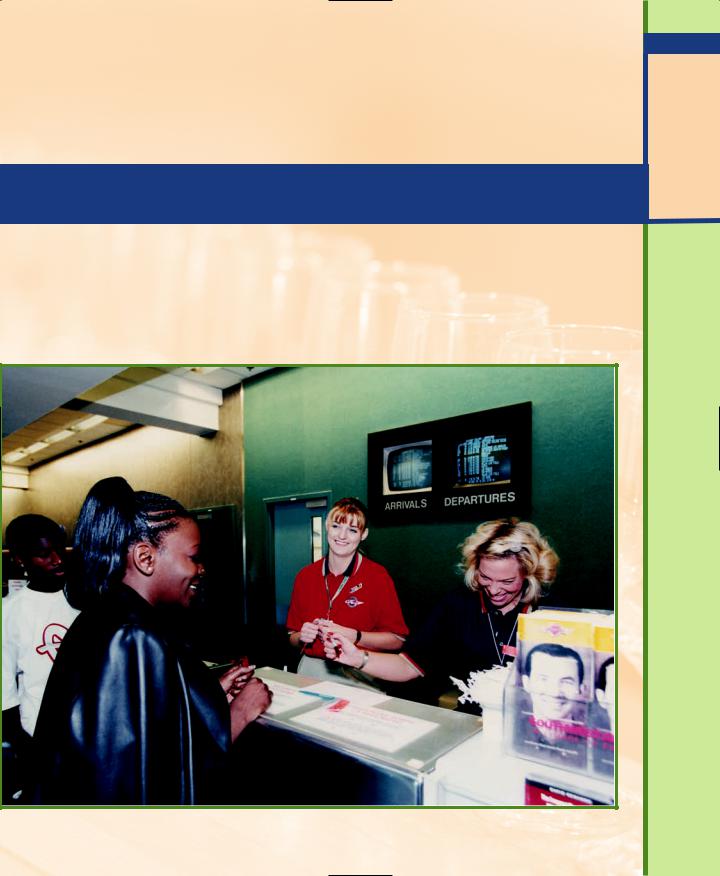
- •CONTENTS
- •PREFACE
- •Content—Benefits for Students
- •Content—Benefits for Instructors
- •Features of the Book for Students and Instructors
- •Supplementary Materials
- •Acknowledgments
- •What Is Hospitality Management?
- •The Manager’s Role in the Hospitality Industry
- •Why Study in a Hospitality Management Program?
- •Planning a Career
- •Employment as an Important Part of Your Education
- •Getting a Job
- •Employment at Graduation
- •The Outlook for Hospitality
- •Summary
- •Managing Change
- •Demand
- •Supply
- •Workforce Diversity
- •The Impact of Labor Scarcity
- •Summary
- •The Varied Field of Food Service
- •The Restaurant Business
- •The Dining Market and the Eating Market
- •Contemporary Popular-Priced Restaurants
- •Restaurants as Part of a Larger Business
- •Summary
- •Restaurant Operations
- •Making a Profit in Food Service Operations
- •Life in the Restaurant Business
- •Summary
- •Chain Restaurant Systems
- •Independent Restaurants
- •Franchised Restaurants
- •Summary
- •Competitive Conditions in Food Service
- •The Marketing Mix
- •Competition with Other Industries
- •Summary
- •Self-Operated Facilities
- •Managed-Services Companies
- •Business and Industry Food Service
- •College and University Food Service
- •Health Care Food Service
- •School and Community Food Service
- •Other Segments
- •Vending
- •Summary
- •Consumer Concerns
- •Food Service and the Environment
- •Technology
- •Summary
- •The Evolution of Lodging
- •Classifications of Hotel Properties
- •Types of Travelers
- •Anticipating Guest Needs in Providing Hospitality Service
- •Service, Service, Service
- •Summary
- •Major Functional Departments
- •The Rooms Side of the House
- •Hotel Food and Beverage Operations
- •Staff and Support Departments
- •Income and Expense Patterns and Control
- •Entry Ports and Careers
- •Summary
- •The Economics of the Hotel Business
- •Dimensions of the Hotel Investment Decision
- •Summary
- •The Conditions of Competition
- •The Marketing Mix in Lodging
- •Product in a Segmented Market
- •Price and Pricing Tactics
- •Place—and Places
- •Promotion: Marketing Communication
- •Summary
- •The Importance of Tourism
- •Travel Trends
- •The Economic Significance of Tourism
- •The United States as an International Tourist Attraction
- •Businesses Serving the Traveler
- •Noneconomic Effects of Tourism
- •Summary
- •Motives and Destinations
- •Mass-Market Tourism
- •Planned Play Environments
- •Casinos and Gaming
- •Urban Entertainment Centers
- •Temporary Attractions: Fairs and Festivals
- •Natural Environments
- •On a Lighter Note. . .
- •Summary
- •Management and Supervision
- •The Economizing Society
- •The Managerial Revolution
- •Management: A Dynamic Force in a Changing Industry
- •What Is Management?
- •Summary
- •Why Study Planning?
- •Planning in Organizations
- •Goal Setting
- •Planning in Operations
- •The Individual Worker as Planner
- •Long-Range Planning Tools
- •Summary
- •Authority: The Cement of Organizations
- •Departmentalization
- •Line and Staff
- •Issues in Organizing
- •Summary
- •Issues in Human-Resources Management
- •Fitting People to Jobs
- •Recruiting
- •Selection and Employment
- •Training
- •Retaining Employees
- •Staff Planning
- •Summary
- •The Importance of Control
- •Control and the “Cybernetic Loop”
- •Tools for Control
- •Summary
- •Leadership as Viewed by Social Scientists
- •Why People Follow
- •Leadership Theories
- •Communication
- •The Elements of Leading and Directing
- •Developing Your Own Leadership Style
- •Summary
- •A Study of Service
- •Rendering Personal Service
- •Managing the Service Transaction
- •How Companies Organize for Service
- •Summary
- •INDEX

Promotion: Marketing Communication |
405 |
Promotion: Marketing Communication
Marketing communication is persuasive communication. It uses the tools of mass communication and individualized communication to encourage patronage of a hotel or a group of hotels such as a chain or franchise group. Advertising, sales
promotion, and public relations are the principal mass-medium selling tools.
Until quite recently, individualized communication for hotels largely meant personal selling. Although personal selling is still a vital tool of hotel marketers, an increasingly important role is played by individualized communication based on information about customers (and people similar to them) captured in the databases of guest history systems and transaction records, which we will discuss in a moment.
ADVERTISING IN MASS MEDIA
Advertising is paid communication. It uses print media (a favorite among hotels) such as newspapers and magazines; electronic media such as television, radio, and the Internet; and outdoor media such as billboards. Another mass medium is direct mail, but the possibilities for individualizing direct-mail offers have been multiplied so greatly by the databases mentioned earlier that we need to qualify its classification as a mass medium.
Advertising carried out by the individual property may be aimed at the local community as well as directed at potential guests in cities that serve as a major point of origin for visitors. Brand advertising is carried out by chains and franchise and membership organizations. Hotels experienced significant declines in marketing budgets after September 11. These declines continued into 2002 and 2003. Some properties found creative approaches to maximize the limited marketing dollars. Sandestin Golf and Beach Resort, for example, entered into a number of partnerships, most notably with the local tourism commission to sell beach towns along the Gulf Coast in Florida as destinations. Other hotels have experienced similar benefits from partnering with state tourism commissions and convention center groups. E-mail blast advertising is also on the increase, costing less than one cent per blast compared to the seven cents per postcard. Marketing budgets started to increase in 2004 and 2005 saw 5.1 percent of revenue in full service hotels going to marketing as compared to 4.3 percent in 2004.20
Even with larger budgets, hotels have to be aware of the return on investment of marketing dollars. Many properties have decreased spending on television and radio ads because it is hard to track the impact of that type of advertising. Print, which is much more trackable, allows a hotel to have more certainty regarding its return on investment.

406 |
Chapter 12 Competition in the Lodging Business |
The online distribution channels have continued to have sizable marketing budgets. Hotels.com, one such online service, outspent all the major hotel chains, with an advertising budget for 2003 of $56 million. Hotels.com extended its target market beyond the price-sensitive traveler to those who might pay more to get what they want. Although the budget is big, the company does not spend indiscriminately. Production, media buying, and online ad serving are all done in-house in addition to monitoring and tracking. In May 2003, Hotels.com was the top online booking site with a 42 percent share of the 32 million online impressions received by the top ten sites.21
ADVERTISING ON THE INTERNET
Hotels are turning to Internet advertising with their more limited marketing budgets. This form of advertising is trackable and has been demonstrating noteworthy returns on investment. The advertising landscape has been shifting with customers who are using Web sites run by airlines and hotels over the big travel sites like Orbitz, Expedia and Travelocity. New rivals for online travel searches have also emerged. Meta-search sites like SideStep and Kayak scan the inventories of dozens of airline sites as well as online travel agencies like Orbitz. Internet giants such as Yahoo and AOL have also upgraded their travel sites.22
Internet advertising involving hotel Web pages typically feature photographs and information on the hotel and the surrounding area. Most Web sites have the capability for guests to make reservations. Many Web sites offer visitors the opportunity to take a virtual tour of the hotel, including guest rooms, restaurants, lobby, and pool, spa, or recreational areas.
At Marriott’s Web site (www.marriott.com), visiting customers can use a mapping system to locate any Marriott, Courtyard, Residence Inn, or Fairfield Inn in the United States. Once the location is mapped, the visitor may zoom in or out for desired detail. Also, at the click of a button, the system can calculate estimated driving times and road-by-road directions to and from any location, including any of the 16 million businesses and attractions found in the database. Westin Hotels & Resorts is using the Internet to feature a program called, “Westin Sights and Sounds.” Created by MSN, Web surfers can experience five-minute vacations with soothing music and different Westin properties.23
Boston’s convention and visitor bureau has a site (www.meetingpath.com) where Boston-area hotels can post short-term guest room availability. New England hotels that participate in the site can display detailed text and graphics to describe their properties.24

Hilton is one hotel chain that offers a reward program for loyal customers. (Courtesy of Las Vegas Convention and Visitors Authority.)
SALES PROMOTION
Sales promotion is “a marketing communication activity which offers an incentive to immediate action.”25 At the property level, sales promotions are often special events or individualized rewards for frequent guests.
One of the most common forms of sales promotion has as its target customers who are already patronizing the system’s hotels. These are the frequent-traveler programs.
Partnerships and Reward Programs. Frequent-guest clubs offer regular guests a reward for brand loyalty. Frequent-stay programs may be a hotel chain’s biggest marketing expense, yet the hope is that they instill loyalty that helps drive business. Such programs also provide opportunities to collect more and better information about customers.26 With price being a major determinant in hotel selection, particularly among the leisure segment, the concept of “brand loyalty” among the buying public has been recently questioned, particularly with the competitive shopping advantages offered by the Internet.
The first hotel frequent-guest program was introduced in 1983 by Holiday Inns, followed quickly by Marriott. Early in the process, hotels learned that many guests preferred air miles to hotel points, which were exchangeable only for free hotel stays. As a result, hotels formed partnerships with airlines. Hotels purchased frequent-flyer miles at wholesale rates and offered their guests a choice between airline miles or points good for hotel stays. As airline partners, the hotels also receive favorable coverage in airline frequent-flyer publications. The partnership makes especially good sense for hotels, because the largest hotel programs have over 10 million members, while major airlines have more than 20 million members. Most hotel programs offer miles, points, or both. Points
407

408Chapter 12 Competition in the Lodging Business
can be either converted into air miles, used to purchase merchandise, or used for hotel stays. The merchandise programs were begun when hotels discovered that the most frequent travelers had more frequent-flyer miles than they could use and were interested in some other form of reward. Hilton’s HHonors program even provides vacation benefits for members when buying, selling, financing, or refinancing a home with their “Awards for Mortgage and Real Estate.”27
Frequency Marketing and Databases. Frequent-traveler programs do more than reinforce customer loyalty. They provide a wealth of detailed information on customers. From membership information, hotels can learn about the demographics of their customer base, as well as where they come from. From transaction records, it is possible to build up a record of individual spending patterns and preferences. These databases permit hotels to learn who their best customers are. They also make it possible to cus- tom-design offers to guests, which can be delivered by direct mail or phone. Does a guest come most frequently in the fall? Perhaps he or she would like to see the area in the spring. Had the guest been coming regularly but has not visited the property for some time? Is something wrong? What needs to be done to remedy the problem?
Moreover, once a profile of the hotel’s best customers has been developed, it is possible to purchase other databases on people who have a similar profile:
Many hotel companies overlay an online data base with information from credit card companies or transportation companies. Secondary overlays are available from geodemographic and psychographic information firms. In combination, the data from these external sources provide invaluable enhancement to a hotel’s inhouse records.28
Summary
Our discussion of competitive practices was structured by the model of the marketing mix. Competition should be proactive, not reactive. In each element of the marketing mix, there is a tool for reaching and attracting guests. With the development of data-based marketing, moreover, the appeal can be more carefully crafted to motivate our guests and people like them, and even to reach them individually with the
appeal best suited to them.
Product is ultimately the guest’s experience. Ways of improving that experience include food service, other services and amenities, and systemwide services. Limitedservice properties do not offer restaurant service to their “upstairs” guests, but food service continues to be a major competitive tool in reaching the “downstairs” guests

Summary 409
in full-service hotels. Food service is difficult to manage, and some properties have leased their food service operations. This solution has built-in problems related to giving up control of the “service department” of the hotel. Other hotels use franchised restaurants to gain a successful food service format, field supervision, and the power of an additional brand. Still others have sought to limit the problems of and skills required by food service by simplifying their food service operations. The problem with most services and amenities is that many are easily copied and so do not offer differentiation. Systemwide services provided by franchisors include quality assurance for the entire system, an international reservation service, and the establishment and maintenance of a brand name and image.
The low variable cost and consequent wide margin in room sales offer many opportunities for special rates. These are extended to volume customers and, during slow periods, to specially targeted customers such as sports teams. Rates can also vary according to demand as yield management dictates. The practice of yield management runs the risk of offending customers who are charged different rates for the same product at different times. Good practice in yield management dictates full disclosure of pricing to customers and restrictions on rooms sold at lower rates, such as advance purchase or minimum stay.
Place refers not only to the property’s location but also to the channels of distribution. Promotion or marketing communication uses mass advertising in the electronic and print media. Brand advertising in large chains involves very large expenditures to establish and maintain a brand name and image. The Internet has become prominent in advertising, and interactive Web sites make the Internet an additional channel of distribution. Although such mass promotion remains important, hotels are moving toward tighter targeting in their marketing, based on databases made up of information on customers and their transactions.
Key Words and Concepts
Fragmented market |
Differentiation |
Cyclical industry |
Concierge |
Low variable cost |
Fitness facilities |
Securitization |
Spa facilities |
Impact of technology |
Business centers |
Marketing mix |
Quality assurance |
Upstairs guest |
Variable cost |
Downstairs guest |
Fixed costs |
Leasing |
Yield management |
On-site franchised |
Location |
restaurant |
Distribution channels |

410 |
Chapter 12 Competition in the Lodging Business |
Global distribution system (GDS) |
Sales promotion |
Marketing communication |
Frequent-stay programs |
Advertising |
Partnerships |
Review Questions
1.What are some of the conditions of competition in the hotel business? What is their impact?
2.What is the difference between the upstairs and downstairs markets?
3.What is the role of food service in lodging? Why have some segments chosen to reduce or eliminate their food services?
4.What means of differentiation other than food service were discussed in the text? What is your assessment of the effectiveness of each?
5.What is meant by low variable cost in the lodging industry?
6.Describe what yield management is. Discuss the pros and cons of yield management.
7.What is meant by channels of distribution? What are the established channels for hotels? What are the new channels? What is the outlook for travel intermediaries in lodging?
8.What is the impact of partnerships on hotel marketing?
9.What are several of the advantages that have been provided to hotels through the Internet? What are several of the disadvantages that hotels have experienced because of the Internet?
Internet Exercises
1.Site name: Choice Hotels
URL: www.choicehotels.com
Background information: Choice Hotels International is one of the largest and most
successful lodging franchisors in the world with over 405,000 rooms in more than thirty-three countries. Built on the foundation of the venerable Quality Inn brand, a pioneer in consistent mid-priced lodging, Choice Hotels today is the worldwide franchisor of ten branded hotels.
Site name: Wyndham Worldwide
URL: www.wyndhamworldwide.com
Background information: Wyndham Worldwide was previously part of the Cendant group. It is one of the world’s largest hospitality companies spanning six continents and offering individual consumers and business customers a broad array of hospitality products, services and price ranges through a diverse portfolio of worldrenowned brands.

Summary 411
Exercises:
a.Review both of the above sites. How do the Wyndham Hotel group and Choice Hotel Group position themselves to compete with one another?
b.Surf both sites and describe the franchise information that is provided by each company. Which company provides the most extensive information?
2.Site name: Site name: Four Seasons Hotels and Resorts
URL: www.fourseasons.com
Background information: As one of the world’s leading operators of luxury hotels
and resorts, Four Seasons currently manages over 70 properties worldwide. The company also offers a growing network of branded vacation ownership properties and private residences.
Site name: The Ritz Carlton
URL: www.ritzcarlton.com
Background information: Among the grand hotels of the world, the Ritz-Carlton hotels and resorts are renowned for indulgent luxury. Sumptuous surroundings and legendary service are their trademark. They currently manage 58 hotels worldwide (35 city hotels and 23 resorts).
Site name: Rosewood Hotels & Resorts
URL: www.rosewoodhotels.com
Background information: Rosewood Hotels & Resorts is a privately held ultra-luxury hotel management company. Rosewood is a collection of unique hotels that offers luxurious accommodations and personalized service. Each hotel features architectural details, elegant interiors, and innovative culinary concepts that are reflective of the local region where the hotel or resort is located.
Exercises:
a.All three of the above hotel companies compete for the same target population. What marketing strategies do they use to attract customers to their hotels? How do they differ?
b.In your opinion, which hotel company has the best marketing strategies on their Web site? Why?
c.What are the similarities and differences among these three companies regarding how they market their hotels versus how the Choice and Cendant hotel groups market their hotels?
Notes
1.Lodging Econometrics. “LE Revises Supply Side Forecast Downward of ’06 and ’07.” http://www.lodgingintelligence.com/PR/3Q06IndPress.htm.
2.There are a number of other ways of viewing the marketing mix. See, for instance, Leo Renaghan, “A New Marketing Mix for the Hospitality Industry,” Cornell Hotel and

412 |
Chapter 12 Competition in the Lodging Business |
Restaurant Administration Quarterly, August 1981, pp. 32–33. The present view is adopted less as an analytical device than as a means of exposition.
3.The upstairs-downstairs guest dichotomy originated, we believe, with the Marriott organization.
4.La Quinta Support Services, personal communication, February 2001.
5.Judy Liberson, “Strategic Alliances Create Profitable Blend,” Lodging, January 1997, p. 63.
6.Jeff Weinstein. “Don’t Turn F&B Space Into Guestrooms Just Yet,” Hotels, May 1997, p. 17.
7.C. Valhouli, “Super Spas 2005,” Forbes.com, http://www.forbes.com/lifestyle/travel/ 2005/01/20/cx_cv_0120feat.html.
8.David C. Sullivan, executive vice president, Promus, remarks during a panel discussion, “Suite Hotels and Limited Service Hotels.” Hospitality Investment Conference, New York, June 4, 1994.
9.PKF Hospitality Research, Trends 2006.
10.Sheryl E. Kimes, “Perceived Fairness of Yield Management,” Cornell Hotel and Restaurant Administration Quarterly, February 1994, pp. 22–29.
11.Ibid.
12.C. Green. “Are global distribution systems going away? Hardly.” Lodging archives. http://www.lodgingmagazine.com/index.cfm? Fm=Article.Detail&aid=93.
13.“Brand names resonate when it comes to online bookings.” Hotelmarketing.com, December 11, 2006.
14.R. Hill, “Does group booking software have all the answers?” Lodging archives. http://www.lodgingmagazine.com/index.cfm? fm=Article.Detail&aid=104.
15.“Hotel chains report double-digit Internet growth,” December 5, 2006, Hotelmarketing.com
16.PKF Hospitality Research, Trends 2006.
17.Ibid.
18.Ruth A. Hill, “Electronic Partners,” Lodging magazine, February 1998, p. 73.
19.C. Green, Lodging archives.
20.PKF Hospitality Research, Trends 2006.
21.Gary Boulard, “Tightening the Belt,” Hotel & Motel Management, September 15, 2003,
p.44.
22.“Online travel—a big change in direction.” Hotelmarketing.com, April 6, 2006.
23.“Westin, MSN Offer ‘5-Minute’ Vacations.” Hotelmarketing.com, December 5, 2006.
24.Mike Pusateri and Jeff Manno, “Growing with the Web,” Lodging magazine, January 1997,
p.71.
25.Robert H. Marriott, “Promotions—A Key Piece in Your Marketing Puzzle.” Proceedings of the Chain Operators Exchange Chicago International Foodservice Manufacturing Association, 1987).
26.Global Online Retailing,” Ernst & Young, 2001, www.ey.com/global/gcr.nsf/ International/Welcome-Retail.
27.Kathleen Cassidy, “Miles, Miles and More Miles,” Lodging magazine, February 1997,
pp.48–52.
28.Paula A. Francese and Leo M. Renaghan. “Data-Base Marketing: Building Customer Profiles.” Cornell Hotel & Restaurant Administration Quarterly, May 1990, p. 62.

P A R T F O U R
Travel and Tourism

The Hospitality Industry
(Courtesy of Southwest Airlines.)

C H AC HPTAEPRT ETRH IORNTE E N
TheTourism:Hospitality
IndustryFrontandandCenterYou
The Purpose of this Chapter
ravel and tourism at the local, state, national, and international levels are vital to the health of
Tour economy as well as that of the hospitality industry. Indeed, tourism is big business and continues to grow in North America and worldwide. The economic and social impacts of tourism
are significant, and this chapter discusses both of these dimensions.
THIS CHAPTER SHOULD HELP YOU
1.Describe the important impact of tourism on local and national economies.
2.List the factors contributing to the growth of travel and tourism, and explain their impact on the industry.
3.Identify current trends in mode of travel and trip duration.
4.Provide statistics supporting the importance of tourism in generating employment.
5.Explain why international visitors to the United States are an important means of improving the balance of payments and receipts, and how tourism affects international trade.
6.Identify major businesses outside the hospitality industry that service travelers, and explain the trends that are changing the way they do business.
7.List the noneconomic impacts of tourism, both positive and negative.
